The Featured Creatures collection provides in-depth profiles of insects, nematodes, arachnids and other organisms relevant to Florida. These profiles are intended for the use of interested laypersons with some knowledge of biology as well as academic audiences.
Introduction
Melanchroia chephise (Stoll 1782) (formerly Phalaena chephise Cramer 1782), commonly known as the snowbush spanworm, is an occasional insect pest of snowbush shrubs, along with several other ornamental plant species (Caldwell 2007). Found throughout the southern United States (Sanchez et al. 2018), these gregarious moth caterpillars can commonly be found defoliating their chosen hosts soon after they emerge en masse (Caldwell 2007). The colorful appearance of the caterpillars may be alarming (Figure 1), but they pose little risk to people, and usually offer no lasting harm to the plants they feed on. The adult moths, with their black and white wings, can be an attractive addition to a pollinator garden.
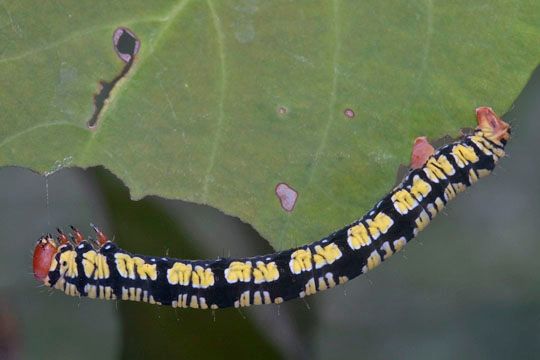
Credit: Alan Chin-Lee, used with permission
Distribution
Melanchroia chephise can be found ranging from the southern parts of North America through South America and the Lesser Antilles (Figure 2) (Sanchez et al. 2018). They have been found as far north as Wisconsin, though this is far outside of their usual range (Devitt 2017).

Credit: Map accessed from North American Moth Photographers Group.
Description and Life Cycle
Eggs
Eggs of the snowbush spanworm are oval and about 0.7 mm in diameter. They have a salmon-pink to yellow coloration with a pebbled surface (Figure 3) (Caldwell 2007). The eggs of the snowbush spanworm are deposited individually at the base of leaf petioles (structures attaching leaves to stems) on their preferred host plants (Caldwell 2007). Eggs take approximately six days to hatch into caterpillars (Sanchez et al. 2018).
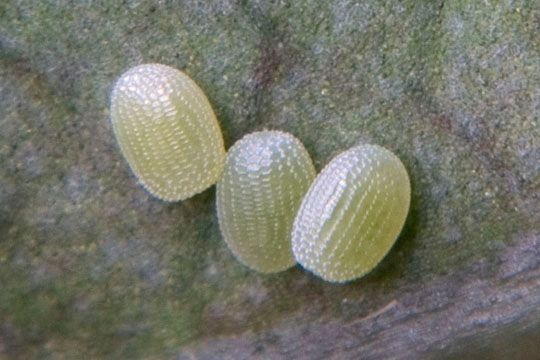
Credit: Alan Chin-Lee, used with permission
Larvae
Larvae are banded in white and black stripes that transition toward yellow and black as the caterpillar matures (Figure 4). Their heads and two pairs of prolegs (false legs appendages along the abdomen) are reddish-orange in coloration. They move by arching their backs and then pushing their front end forward in a classic ‘inch-worm’ movement. At full size they can reach up to 25 mm (approximately 1 inch) in length (Caldwell 2007). Larvae develop through six molts, feeding at the top of their host plant and working their way down (Caldwell 2007). They remain in the larval stage for up to 18 days.
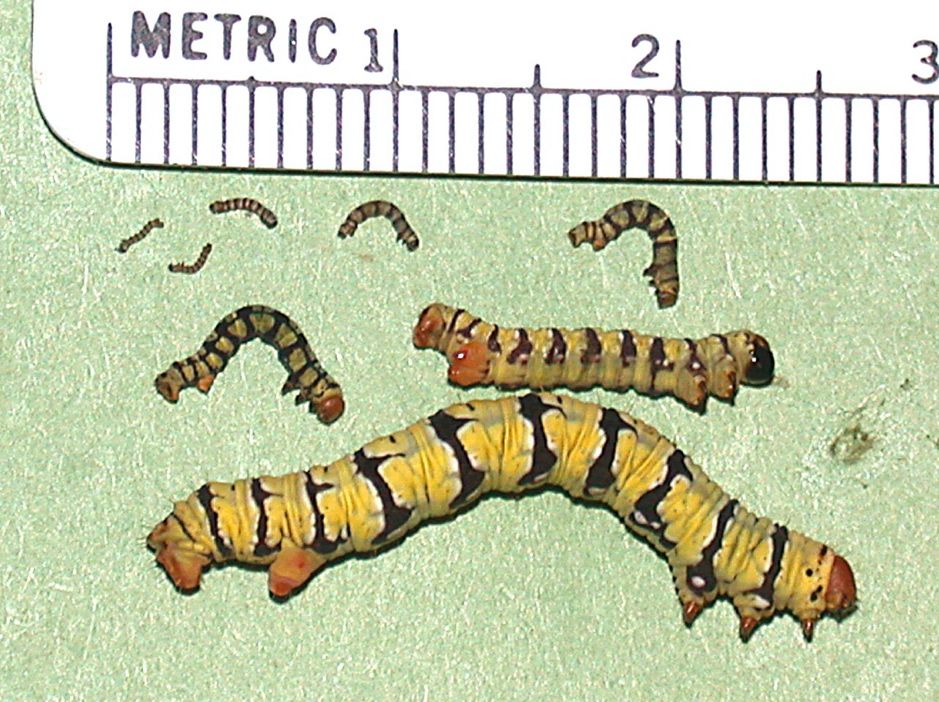
Credit: Doug Caldwell, UF/IFAS Extension Collier County
Pupae
Pupae are around 10 mm (approximately 0.5 inches) in length (Caldwell 2007). Antennal segmentation can be seen in the pupae casing, and they are brown in coloration (Forbes 1945). Pupae can be found either in the foliage of their host plant or in the leaf litter beneath it (Figure 5) (Caldwell 2007). They remain in the pupal stage for up to seven days (Sanchez et al. 2018).
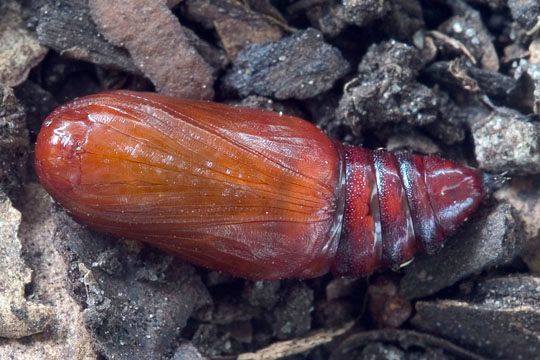
Credit: Alan Chin-Lee, used with permission
Adults
Both male and female Melanchroia chephise adults have bipectinate (feather-like) antennae. Their wings are black or dark brown and usually have a white or yellow blotch on the tip of the forewings (Figure 6). Both males and females have rusty brown thoraxes. Abdomens are black, though males will have a tuft of rusty orange setae (hair-like structures) at the end of their abdomens (Pitkin 2002). Melanchroia chephise are day-flying moths, and females produce a pheromone to draw in males as potential mates (Caldwell 2007).
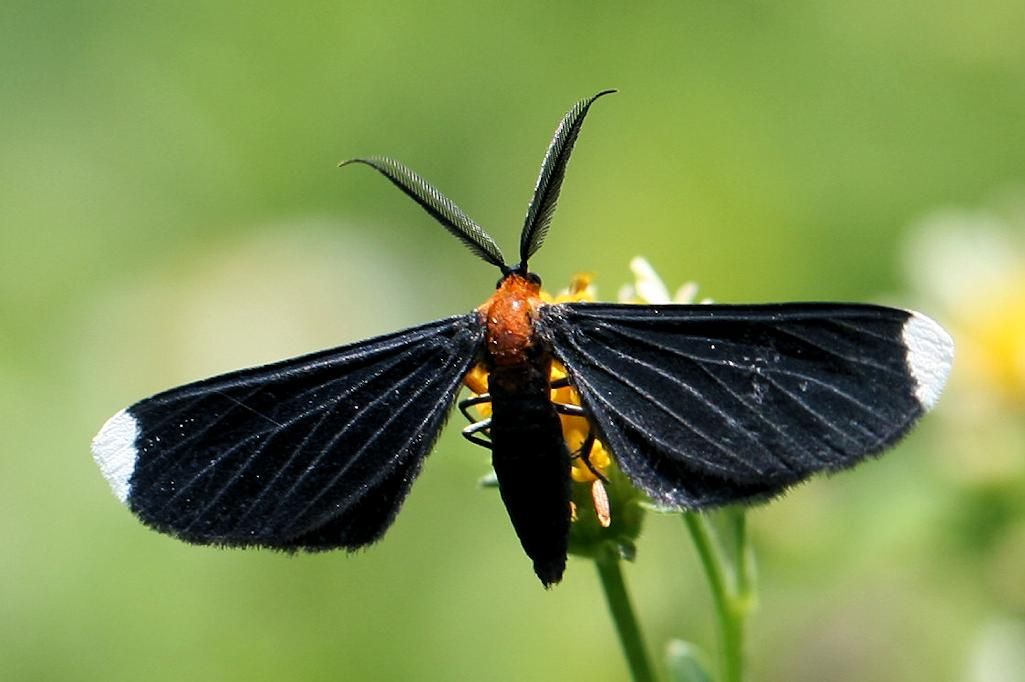
Credit: Don Hall, UF/IFAS
Host Plants
In Florida, the most common host plant is the snowbush (Breynia nivosa). Other host plants include edible amaranth (Amaranthus tricolor (Amaranthaceae)), white sapote (Casimiroa edulis (Rutaceae)), snow-on-the-mountain (Euphorbia marginata (Euphorbiaceae)), Otaheite gooseberry (Phyllanthus acidus (Euphorbiaceae)), and foliage flower (Phyllanthus angustifolius (Euphorbiaceae)) (Heppner 2003).
Economic Importance
This insect is generally of minor economic importance, as it is only an occasional pest, and when it does become a pest its effects are not typically long-lasting. While occasional outbreaks can defoliate snowbushes in a localized area, the host plants usually recover with minimal treatment. The aesthetic value of infested or damaged shrubs may be reduced for a season or several months if heavy defoliation occurs (Caldwell 2007). Such instances can reduce plant marketability or warrant plant managers to intervene with some form of control.
Damage
The damage caused by Melanchroia chephise can be distressing to homeowners who encounter it for the first time, but the snowbush is generally a vigorous grower and will recover with little to no intervention (Caldwell 2007). These caterpillars can defoliate a snowbush when they are present in large numbers. Occasionally, once the foliage has been consumed they will even chew the bark from the twigs, leaving damage that looks like that caused by rabbits or other vertebrates. In some cases, this bark feeding damage can girdle the stems, cutting off nutrient and water circulation and causing the attached foliage to die (Figure 7). Shrubs defoliated in this way that do not die may take a month or more to recover (Caldwell 2007). If stems are girdled by a large infestation of caterpillars, extensive pruning to reduce stems back below the girdling damage may be required to encourage plant recovery and new growth.
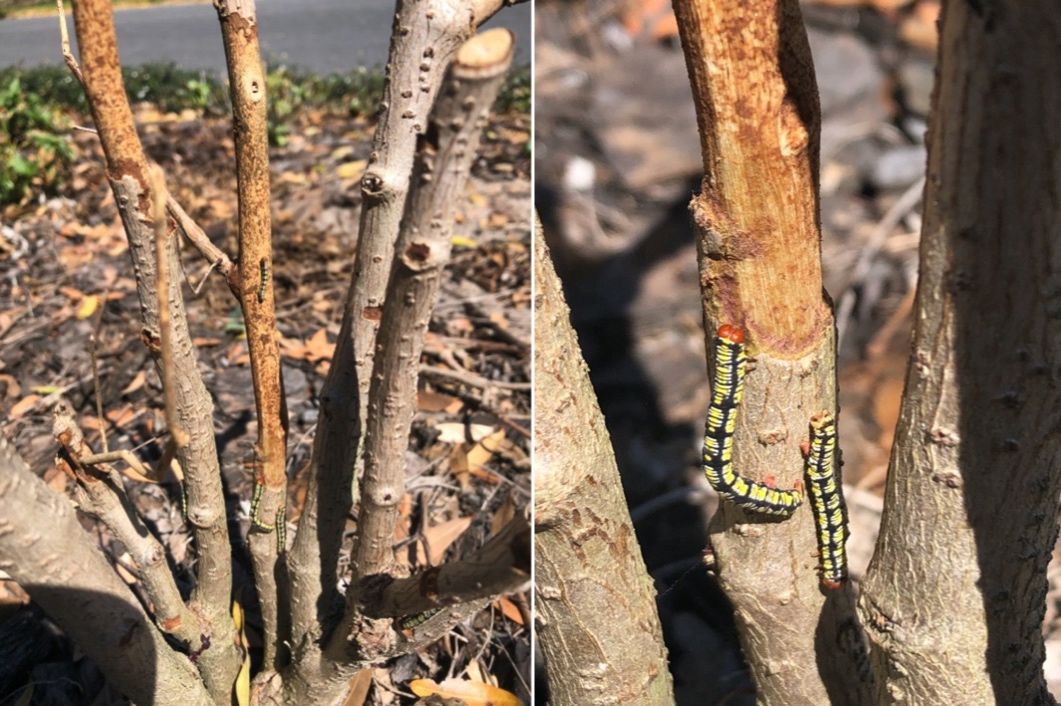
Credit: Dr. Chris Marble, UF/IFAS Mid-Florida Research and Education Center
Management
Cultural control
Proper plant maintenance is the best approach to minimizing the risk of infestation and damage. Choosing shrubs that are not a host plant to this caterpillar and increasing the diversity of plants in the landscape can reduce the incidence of outbreaks. A monoculture of snowbush introduces the possibility of extensive damage if there is a Melanchroia chephise infestation.
Mechanical control
Hand picking the caterpillars or pruning away the tips of heavily infested branches before the caterpillars disperse throughout the shrub can immediately reduce caterpillar numbers and may effectively control the infestation.
Chemical control
In some cases, insecticides may be warranted to suppress infestations and protect plant health and value. Bacillus thuringiensis, a naturally occurring bacteria commonly sold as an insecticide will effectively control this caterpillar pest. Other insecticides that effectively control caterpillar pests include chlorantraniliprole and Spinosad. Be sure to apply products following label directions and choose products that will suppress your target pest without affecting nearby beneficial organisms. Insecticides that control caterpillars should not be used in a pollinator garden where desirable caterpillars are present as they will also kill those caterpillars.
Selected References
Caldwell DL. 2007. Caterpillar Outbreaks: Defoliation by the Royal Poinciana Caterpillar (Melipotis acontioides) and the Snowbush Caterpillar (Melanchroia chephise) in Naples, Florida. Proceedings of the Florida State Horticulture Society 120: 360-362.
Devitt T. 2017. Tropical Moth Spotted at UW Botany Garden. Wisconsin Entomological Society Newsletter 44: 11.
Forbes TM. 1945. The Ennomid Pupa (Lepidoptera, Geometridae). Journal of the New York Entomological Society 53: 177-210.
Heppner JB. 2003. Arthropods of Florida and Neighboring Land Areas: Volume 17 Lepidoptera of Florida. Gainesville: Florida Department of Agriculture & Consumer Sciences.
Pitkin LM. 2002. Neotropical ennomine moths: A review of the genera (Lepidoptera: Geometridae). Zoological Journal of the Linnean Society 135: 121-401.https://doi.org/10.1046/j.1096-3642.2002.00012.x
Sanchez EA, Luna TA, Hernandez D. 2018. Primer Registro de Melanchroia chephise stoll, 1782 (Lepidoptera Geometridae) Sobre Phyllanthus niruri Y Breynia disticha (Phyllanthaceae) en el Estado Lara, Venezuela. Saber, Universidad de Oriente, Venezuela. 30: 418-421.